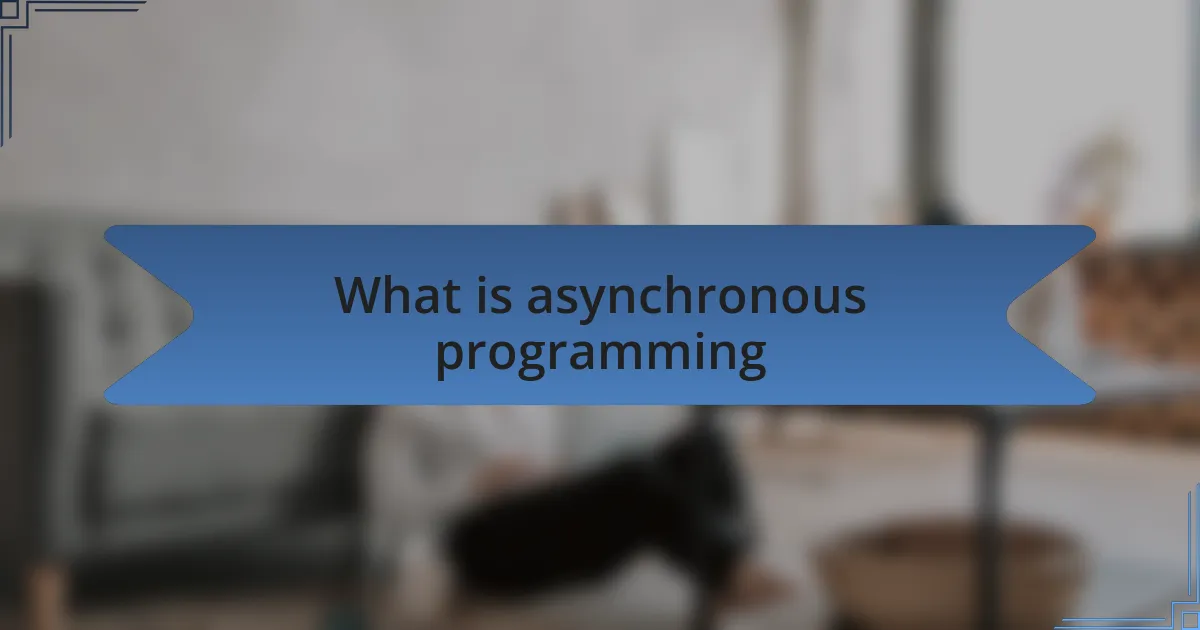Key takeaways:
- Asynchronous programming enhances application performance by allowing non-blocking operations, improving user experience while tasks run in the background.
- JavaScript features like callbacks, promises, and async/await simplify handling asynchronous tasks, making code cleaner and more manageable.
- Transitioning from callbacks to promises and then to async/await fosters creativity, boosts productivity, and improves error handling in coding.
- The importance of collaboration and sharing insights with team members can lead to breakthroughs and a deeper understanding of asynchronous programming challenges.

What is asynchronous programming
Asynchronous programming is a method that allows code to run in a non-blocking manner, enabling other operations to be executed while waiting for tasks to complete, like fetching data from an API. I remember the first time I encountered this concept; it felt like unlocking a new level in a game where I could accomplish multiple tasks without waiting for each one to finish.
Have you ever felt frustrated waiting for a webpage to load, only to realize that the browser could be doing other tasks in the meantime? That’s the essence of asynchronous programming. It allows applications to remain responsive, giving users a smoother experience while intensive processes run in the background. I recall working on a project where implementing an asynchronous approach significantly improved load times, which made the users happy—something I will always cherish.
In JavaScript, this concept is crucial, primarily because of its single-threaded nature; it can only execute one command at a time. Using callbacks, promises, or async/await syntax, we can manage operations effectively without freezing the application. I often find myself reflecting on how embracing these tools transformed my coding style, sparking a sense of creativity in how I tackled complicated problems.

Importance of asynchronous programming
Asynchronous programming holds immense value in crafting high-performance applications. For instance, I remember a time when I worked on a data-intensive application. The difference was striking—applying asynchronous techniques allowed the app to fetch data seamlessly while users interacted without interruption. It was rewarding to witness firsthand how this approach kept everything fluid and engaging.
Think about the last time you used an online service and it felt quick and responsive. That sensation isn’t just luck; it’s asynchronous programming at work. I once developed a feature that tracked live data, and without this method, the experience would have been clunky. Users would have faced delays, likely leading to frustration. Thanks to an asynchronous model, that feature became one of the app’s highlights!
The importance of asynchronous programming also extends to handling large data sets efficiently. I frequently find myself reflecting on a project where I had to process thousands of records. By leveraging asynchronous calls, I could batch requests and ultimately reduce wait times dramatically. Have you ever had an idea that felt transformative? This method certainly felt like a lightbulb moment for me, showcasing how powerful efficient coding can be.

Overview of JavaScript async features
JavaScript’s asynchronous features, such as callbacks, promises, and async/await, revolutionize how we handle tasks. I distinctly remember when I first encountered callbacks—they felt like a revelation. They let me execute code after a certain task completed, sparking a curiosity in me about how these mechanisms worked behind the scenes.
Moving on from callbacks, I discovered promises, which brought a level of clarity I didn’t know I needed. The chainability of promises allowed me to manage multiple asynchronous operations with ease. Can you imagine writing cleaner, more readable code instead of getting lost in callback hell? This was a game-changer for me, and I’m sure many developers can resonate with that sense of relief.
Finally, async/await introduced a syntax that felt almost synchronous, making my code more intuitive and easier to debug. I recall a particularly complex function that relied on multiple asynchronous requests. After refactoring it with async/await, not only did it improve readability, but it also eliminated nesting, making my work much more enjoyable. Isn’t it amazing how a simple shift in approach can significantly enhance our coding experience?

My approach to callbacks
Callbacks were my initial introduction to asynchronous programming, and they came with a unique mix of excitement and frustration. At first, I found it thrilling to see a function execute after a previous task finished, but as I integrated more callbacks, I quickly learned about “callback hell.” This realization left me wondering, why did the simplicity of calling a function lead to such complex and tangled code?
As I dove deeper into using callbacks, I realized that proper organization was key. By adopting naming conventions and utilizing tabbed indentation, I found a way to navigate the often chaotic structure of nested callbacks. I still remember a project where I had to fetch user data and then process it for display, layering several layers of callbacks. It wasn’t just about getting the code to work; it was also about maintaining my sanity while doing it.
Reflecting on that experience, I’ve come to appreciate the value of documenting my callback functions thoroughly. I always made it a habit to annotate my code, describing the purpose of each callback and its relationship to the overall flow. This practice not only made my life easier but also helped others who might read my code later. Have you ever found yourself lost in your own code? That’s when clear documentation becomes your best friend, transforming a tangled mess into a clearer picture.

Transitioning to promises
Transitioning from callbacks to promises felt like stepping into a new world for me. Initially, promises seemed daunting, but once I grasped their structure, I felt a wave of relief wash over me. The ability to chain .then() methods simplified my code dramatically, transforming what once felt like a labyrinth into a clear path. Have you ever felt overwhelmed by the sheer number of callbacks? I sure have, and promises became my guiding light.
I remember a specific instance while working on an application that required data from multiple APIs. With callbacks, I faced a tangle of nested functions that made debugging a nightmare. Once I switched to promises, I could elegantly manage those requests with ease. Just like that, I could handle errors more transparently using .catch(), which felt like finally finding my way out of the fog.
As I embraced this new approach, I noticed a significant boost in my productivity and confidence as a developer. The anxieties of callback hell slowly faded away, replaced by a newfound clarity in my solutions. It was a game changer—do you think adopting promises could make your coding experience smoother too? I certainly believe it can.

Exploring async and await
Exploring async and await felt like unlocking a whole new level of JavaScript mastery for me. When I first encountered these keywords, I was excited yet apprehensive about their potential. It was a significant leap; using async made functions return promises implicitly, while await allowed me to pause execution until a promise was resolved. Can you imagine how much cleaner my code became? The readability skyrocketed, transforming complex asynchronous logic into a linear flow that was much easier to follow.
I vividly recall a project where I had to fetch and process user data from an external source. Initially, I used multiple .then() chains that quickly spiraled into confusion. When I switched to async/await, it felt like I was finally breathing fresh air. Suddenly, I could write my asynchronous code as if it were synchronous, making it not just more manageable but also more enjoyable. It’s akin to switching from a cluttered desk to a well-organized workspace—everything just clicks into place.
As I delved deeper, I discovered that error handling became more intuitive, too. Instead of cumbersome .catch() methods, I could simply use a try-catch block around my async calls. This had a profound impact on my debugging process. Have you ever found yourself frustrated by your error handling logic? With async/await, those frustrations melted away, paving the way for smoother code execution. It’s moments like these that make me love programming even more.

Lessons learned from my experience
It’s fascinating how understanding asynchronous programming can shift your entire perspective on coding. During one project, I faced a significant challenge with a user authentication flow that relied heavily on asynchronous calls. At one point, I felt completely overwhelmed by the complexity. However, by breaking the logic into smaller, manageable async functions, I not only achieved clarity but also regained my confidence in tackling challenging tasks.
I learned the importance of patience through my journey with asynchronous programming. Initially, I rushed through writing code, expecting immediate results. But when I took a step back and allowed each promise to resolve properly using await, I noticed fewer errors and inconsistencies. Have you ever rushed and regretted it later? It was a powerful reminder to embrace the process and trust the flow of my code.
Finally, I realized that collaborating with my team on asynchronous implementations was invaluable. Sharing challenges and solutions brought new insights I wouldn’t have discovered alone. One discussion about managing race conditions opened my eyes to different patterns and best practices. How often do we miss out on learning by not engaging with others? It reinforced the idea that in programming, as in life, collaboration can lead to breakthroughs we never anticipated.